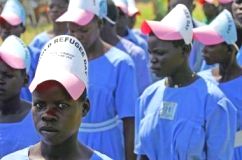Sudanese refugees return with influences from host countries
By Millicent Mutuli
Nov 14, 2006 (YEI, Sudan) -– After decades in exile, thousands of refugees have been flooding back to southern Sudan aboard UNHCR convoys in the past year. They carry their meagre possessions wrapped in old blankets or packed into colourful plastic sacks.
 But many of the returnees are also taking back something less tangible, but just as important – the cultural, linguistic, social and even culinary influences of their host countries, including Central African Republic, Democratic Republic of the Congo (DRC), Ethiopia, Kenya and Uganda.
But many of the returnees are also taking back something less tangible, but just as important – the cultural, linguistic, social and even culinary influences of their host countries, including Central African Republic, Democratic Republic of the Congo (DRC), Ethiopia, Kenya and Uganda.
All these influences come together at primary and secondary schools in Yei, where students share the same homeland and ethnicity but often little else. Grace Taabu’s curtsey on greeting UNHCR visitors to Jigomoni Primary School is an immediate giveaway – the unmistakeable sign of a girl or young woman who has grown up in northern Uganda.
The 16-year-old from Sudan’s Kakwa ethnic group returned home from a refugee settlement in northern Uganda nearly one year ago, but she still cannot shake off her foreign habits. She speaks English with a Ugandan accent and loves eating mashed cooked bananas, a Ugandan speciality known as matoke.
But teachers in Yei welcome the refugee students who have returned from Uganda. “They are more disciplined, their performance is better and they seem to know why they are in school,” said Ojja Ajeo, the director of studies at Yei Girls Secondary School.
She might have added that the girls from Uganda have an advantage because they know English, the main medium of teaching in southern Sudan. Another Kakwa girl, Christine Amudi, has been struggling with the language since arriving in her homeland from the Democratic Republic of the Congo, where French, Kikongo, Lingala, Tshiluba and Swahili are the main languages spoken.
Difficulty with English and an unfamiliar curriculum is holding the 17-year-old back. “When I was in Aba, [an area in north-east DRC], I was already in the first year of secondary school. Now I have been demoted to primary school and I still have problems understanding my lessons because English is very difficult,” said Amudi, who speaks French, Kakwa, Arabic and Lingala.
As if to hold on to her receding Congolese past, she continues to speak a mix of Lingala and Arabic to her mother and siblings. In the school playground, many pupils at Jigomoni speak Arabic.
Andrew Chol, who returned to Yei six months ago, also complains about the use of English in the classroom. His family were displaced and lived in camps in the southern Sudanese town of Juba during the war between the Khartoum-based government and rebels in the south, which ended with the signing of a peace pact in January last year.
Chol, a pupil at Jigomoni Primary School, was taught in Arabic. “English is very difficult, and over here the teachers do not translate the difficult words,” he complained. But teachers at Jigomoni said they were doing their best to help the French and Arabic-speaking Sudanese pupils, including organising special language classes.
Some 1,400 students are enrolled there – nearly twice its capacity – but the school cannot turn students away, regardless of the problems coping with different cultures and languages, said Headmaster James Sebi.
To ease overcrowding, UNHCR has constructed six additional classrooms and is building a girl’s boarding school on the outskirts of Yei. The new boarding school is expected to take in students from the nearby Yei Girls Secondary school.
Meanwhile, two students hoping to join Jigomoni promise to add more spice to the school’s cultural and social scene. Philip Alwara and Aguma Jacques arrived in Yei from DRC with UNHCR assistance in October. The two are ardent lovers of Congolese music and share the “joie de vivre” so common among the Congolese.
The UN refugee agency estimates that since the start of 2005, nearly 90,000 Sudanese refugees have returned to south Sudan from neighbouring countries. More than 14,000 of them have gone back with UNHCR assistance, but some 350,000 Sudanese refugees remain in neighbouring countries. There are an estimated 4 million internally displaced people in the country.
(UNHCR)
